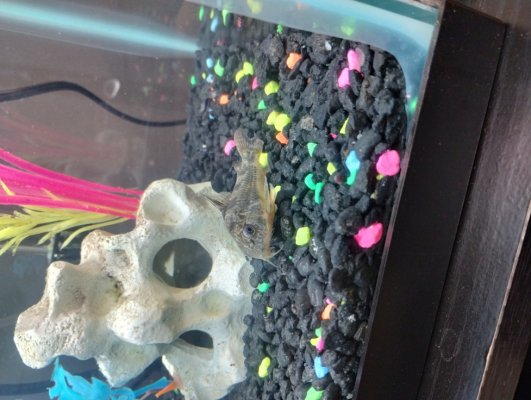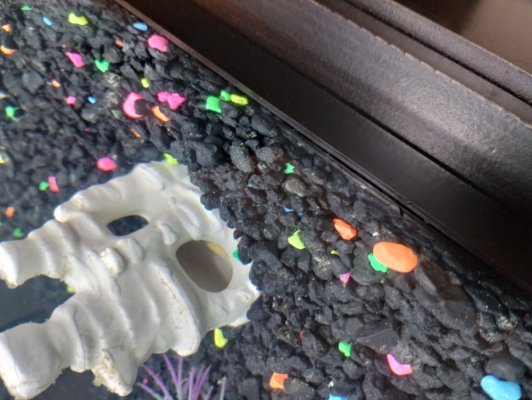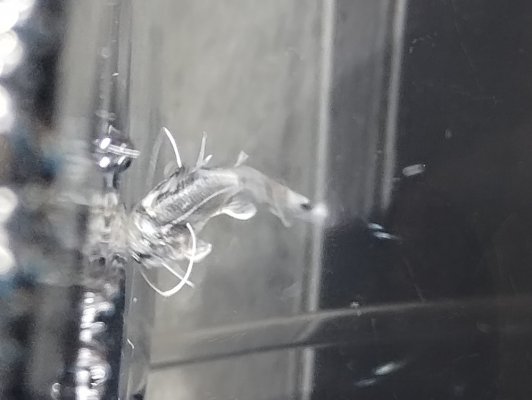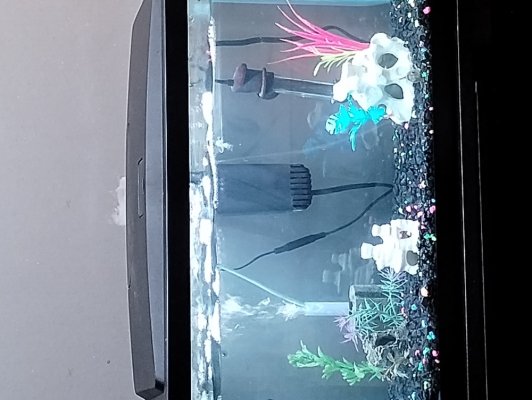The peppered Corydoras has excess mucous on the edge of its tail and on the pectoral (side) fin. That is caused by something in the water irritating the fish. It is usually ammonia or nitrite but can also be heavy metals, chemicals, medications, plant fertiliser, or even pollutants that get into the tank from an outside source (cream, grease, hand sanitiser, etc, on your hands).
Fin degradation is usually caused by poor water quality (ammonia) that damages the tissue and allows harmful bacteria into the wound.
Treatment is big (75%) water changes and gravel cleaning the substrate every day for a week, and maybe adding some salt.
-------------------
One filter is a sponge filter I clean in removed tank water once a week. The other is an Aqueon Quiet Flow Internal Power filter I am now realizing is actually not large enough for this tank. That filter I clean in removed tank water once a month as well as replacing the cartridge once a month and adding Tetra SafeStart with the new cartridge.
You don't want to replace filter cartridges unless they fall apart. The cartridge houses beneficial filter bacteria that help convert ammonia into nitrite, and nitrite into nitrate. If you replace the filter media (cartridge/ pads, sponges, etc), you get rid of the good bacteria and can have ammonia and nitrite problems.
You have a second filter that is probably holding a lot of good bacteria but it might get overloaded with ammonia when you change the filter cartridge in the second filter. This could cause ammonia problems for a few days and this might be the cause of the fin damage
You can normally replace filter pads/ cartridges with sponge from a different brand of filter. Just find a sponge that is the same size or slightly bigger than the cartridge and cut it to fit. Sponges last for years and don't need replacing until they start to fall apart.
You probably don't need to change the power filter to a bigger one. Not all fish come from fast flowing water and even fish that do, tend to have calm sheltered areas to hang out in when not swimming into the currents.
-------------------
The pictus is now swimming around the top of the tank, and Porky is beginning to act sluggish. The new cory is still hiding.
Could it somehow be related to oxygen levels, and how can I check this?
You can buy Oxygen (O2) test kits and monitor the oxygen levels. However, you have a reasonable amount of air coming out of the sponge filter and that should be adequate for the tank, especially considering there are only a few small fish in it.
-----
Basic First Aid for Fish
Test the water for ammonia, nitrite, nitrate and pH.
Wipe the inside of the glass down with a clean fish sponge. This removes the biofilm on the glass and the biofilm will contain lots of harmful bacteria, fungus, protozoans and various other microscopic life forms.
Do a 75% water change and gravel clean the substrate every day for a week or until the problem is identified. The water changes and gravel cleaning will reduce the number of disease organisms in the water and provide a cleaner environment for the fish to recover in. It also removes a lot of the gunk and this means any medication can work on treating the fish instead of being wasted killing the pathogens in the gunk.
Make sure any new water is free of chlorine/ chloramine before it is added to the tank.
Clean the filter if it hasn't been done in the last 2 weeks. However, if the filter is less than 6 weeks old, do not clean it. Wash the filter materials/ media in a bucket of tank water and re-use the media. Tip the bucket of dirty water on the garden/ lawn. Cleaning the filter means less gunk and cleaner water with fewer pathogens so any medication (if needed) will work more effectively on the fish.
Increase surface turbulence/ aeration to maximise the dissolved oxygen in the water.
-----
It's a reasonably new set up so probably doesn't need the glass wiped down.
You clean the filters regularly so you probably don't need to do that.
The picture shows a fair amount of aeration from the sponge filter so that's probably ok.
Your fish are showing signs of stress associated with a water quality issue and water changes should help. I would be doing a 75% water change and gravel cleaning the substrate every day for at least a few days (preferably a week) to see if it helps. If there's no improvement after a couple of water changes, post more pictures of the fish, but at this stage, I reckon it's a water quality problem.




